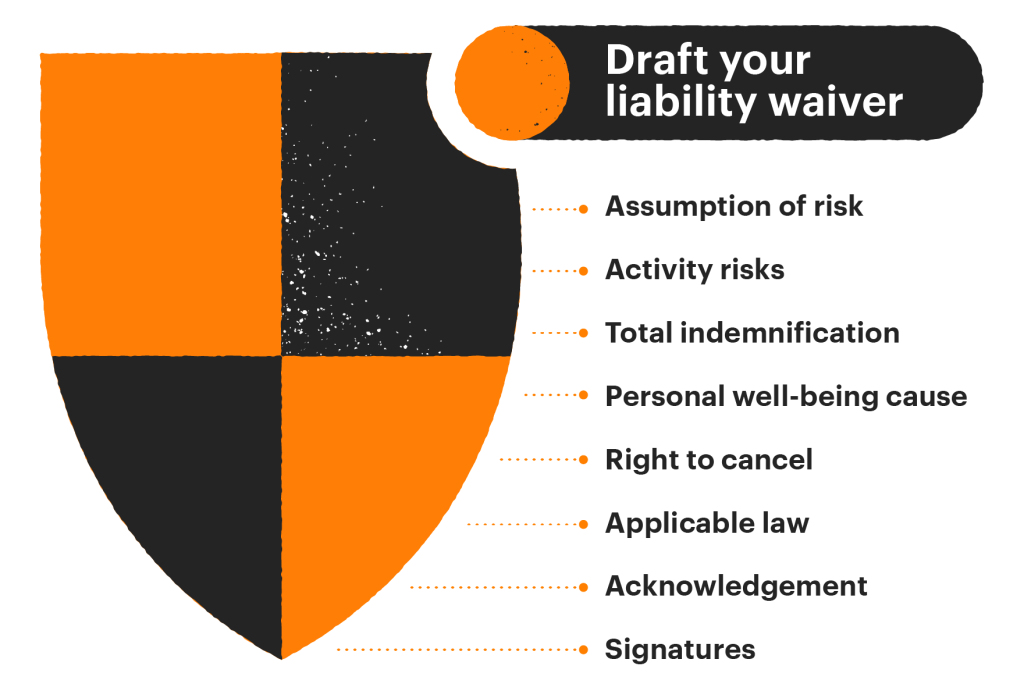Legal documents play an essential role in any company. They protect the interests of an organization and its business owners, as well as enable the safe and smooth functioning of the enterprise.
At or near the top of that document list for any customer-facing business are legally binding liability waivers.
Companies must insulate themselves from being sued as a result of consumer risk, accidents, unintentional wrongdoing, or so-called ordinary negligence (which is different from gross negligence).
They need to have a clear policy of exactly where liability exists between parties, and then signed waivers to back it up.
Failure to do so properly, like relying on substandard and/or messy documentation, can cause significant financial losses, or even place a business in jeopardy. (So a big “no” to taking shortcuts here.)
You want to succeed in business, and we’re here to help you achieve success — read on to understand why having a cohesive liability waiver in place is so important and learn how to execute one correctly.
What is a waiver of liability and what makes it valid?
Waivers are widely used by companies that organize events and/or provide services involving extreme sports — think marathon runners, kitesurfing students, participants of a scuba diving tour, etc.
But acknowledging (legal) responsibility is an everyday occurrence for all of us, from accepting physical liability if things don’t go well during an OrangeTheory class to agreeing to financial liability when playing by Apple’s rules while accessing their products.
A liability waiver becomes a binding legal document once signed.
This means the signatory:
- Is informed about potential risks involved in participating in an activity.
- Agrees not to sue the company issuing the waiver in case of a stipulated event or occurrence.
For organizations, it’s a way to protect themselves from financial responsibility. A customer who signed a waiver cannot hold the business liable for the damages, though they may still file an insurance claim.
If your business involves any inherent risk, you will definitely benefit from a properly written liability waiver.
How to write a comprehensive liability waiver
Step 1. Do you homework
Look at it this way: when crafting your company’s liability waiver(s), you don’t need to reinvent the wheel so much as you simply need to find the right set of (indemnifying) tires.
Start by researching industry standards.
Search trade publications, check how other companies operating in similar fields prepare their waivers, even take a peek at how your competitors do it — chances are “high” that skydiving company A and skydiving company B both have customers sign something pretty similar before parachutes get strapped on.
At the same time, check the local regulations, particularly with respect to your industry and the limitations of liability.
Waivers hold different powers in different states, so be sure to understand their legal strength in your jurisdiction, and detail the requirements your documents must comply with.
Go through a spectrum of already existing solutions and take what’s best for you — and arrive at a solution that doesn’t risk violating your state’s public policy.
Step 2. Explain the risks involved
This kind of legal document must provide a complete explanation of what may occur when partaking in the activity.
For example, your purchase of an amusement park ticket likely indemnifies the park to many, but not all, “possible mishaps” during your visit.
Likewise, pre-surgery consent forms at your doctor’s office will almost certainly exclude staff from anything other than undeniable gross negligence or malpractice should something unplanned occur.
And “possible mishaps” is the opposite of what you want to hear post-surgery — always read before you sign, please!
Detailing potential outcomes, however remote, is a way to ensure that participants make a conscious decision about going forward with the arrangement you’ve set in place — that they are absolutely clear about what their participation entails, and they fully understand that your company won’t cover any costs in case of damages resulting from the risks mentioned.
Be sure to exercise caution (take your time) and provide a thorough explanation of what the customer is liable for should anything unexpected transpire.
Step 3. Talk to your legal team
This is pretty fundamental. Even if your “team” is one lawyer on an as-needed basis or occasional retainer, this is a good idea to ensure that the language is phrased just right.
Step 4. Draft your liability waiver

It’s now time you start drafting the actual waiver. To save you time on writing the whole document from scratch, we’ve prepared a universal waiver agreement template.
Let’s review what a liability waiver should include.
1. Assumption of risk
The document must include a clause in which a signatory states that they participate in the activity/event, as well as sign the waiver, voluntarily.
They also have to confirm that they do so at their own risk and that they are aware that all the risks and liability are on their end.
2. Activity risks
Use the list you prepared above. Again, the waiver should mention all the risks involved so that the participants are fully aware of those before they decide whether to participate.
An appropriate reference point here is what ski resorts expect of their clientele before allowing them to hit the slopes.
In essence, this clause must make it clear that your customers understand that they — and not your company — will be responsible for any expense in case of damages resulting from the assumed risks.
3. Total indemnification
According to this part, a signatory will cover all costs in case of any damage they cause to your business, including the legal expenses in case they sue you.
For example, if you’ve ever rented a car (and declined the suggested “benefit” of buying insurance for the rental), you know that you’ve all but agreed to pay for everything that could ever happen to or with that car until you bring it back to the lot with a full tank of gas.
4. Personal well-being cause
Here, the client confirms that they are physically and mentally capable to participate in the event/activity.
The document may require the signatory to provide information about their health conditions related to the activity they will participate in.
For example, in the case of scuba diving, there are a number of health prerequisites regarding respiratory and circulatory systems, etc.
5. Right to cancel
To ensure that you have the authority to deny someone’s participation after they sign the waiver, be sure to include a clause entitling you to do so.
Failure to stipulate this policy invites a plethora of potential headaches. If something goes wrong, you can expect to:
- Be sued into oblivion (lawyers love lawsuits).
- Be consumed with combatting reputational damage IRL, as well as across social media.
- Be forced to reallocate finances because business is suffering (and you need to pay lawyers).
6. Applicable law
In case of a dispute or a lawsuit, you should specify which laws will be applied. It’s especially important in cases when you sign the waiver with people coming from abroad, or when the activity requires travel.
The laws and regulations governing a particular industry in the U.S., for example, maybe considerably different than those in the EU.
It’s always a good practice to clarify as much as possible in any legal document. If you work with international clients, you can check how electronic signature laws affect legality across different countries to make sure the waivers you sign are legally binding.
7. Acknowledgement
At the end of the document, there must be a section in which the client confirms that they have read and understood the waiver and that they agree to its terms.
8. Signatures
The acknowledgment should be followed by the signatures of both parties (the client and yourself) together with the date of signing.
Step 5. Time to sign
Participants should never be or feel forced to sign the liability waiver. You are obliged to give them enough time to read and review the papers.
To make it easier to sign, store, and access the company documentation, we recommend using eSignatures. And, just to be clear, that’s our bread and butter. We’ve got you covered!
Finally, keep in mind that liability waivers play an important role in many industries that come with intrinsic risk.
They’re crucial for businesses to protect themselves from undesired or unwarranted financial responsibility and should be drafted carefully, ensuring compliance with local and state regulations.
All your bases must be covered, the language clear, and the signatory fully informed and prepared to sign voluntarily.
Frequently asked questions
-
You should have waivers signed when your business involves any inherent risk, especially when operating in event-based, extreme sport, and/or tourism industries.
-
Yes, you can write a basic liability waiver for your business on your own, as well as use a template to help get started. Keep in mind that a poorly drafted waiver may be rejected in court.
In most cases, having your liability waiver written or reviewed by an attorney who’s experienced in your industry, business model, and local regulations is worth the effort and expense. This helps ensure that your company gets the most effective document, one that discourages potential lawsuits.
-
If there is a signed document between two parties with the clear, concise, detailed language as we’ve suggested implementing above, and the signatory signed the waiver voluntarily and fully understanding their acceptance of risk, then that is considered a contract and therefore legally binding.
Because it is a signed contract between two consenting parties, a court or judge will view it as such.
However, there is case law that shows how liability waivers can be ruled invalid — and therefore unenforceable — because they have been deemed to violate public policy. And this varies from state to state.
So the answer here is to be 100% up to speed on laws and regulations for both your industry and your location of business.
-
A liability waiver and a release of liability are both legal agreements signed to transfer responsibility in order not to get sued in court. However, the documents work differently and the terms shouldn’t be used interchangeably.
By signing a waiver, a person agrees to abandon a right they would otherwise have. A release, on the other hand, results in transferring the rights to another person.
Let’s say you collaborate with a copywriter. If they sign a waiver regarding the intellectual property rights, anyone who has access to the texts written by the freelancer will be allowed to use them as they please. If you sign a release with the copywriter, they will transfer the intellectual property rights to you, and you will be the one managing the rights to the texts.
If it seems like you need a release rather than a waiver, take a look at the release of liability form template prepared by our team.
Disclaimer
Parties other than PandaDoc may provide products, services, recommendations, or views on PandaDoc’s site (“Third Party Materials”). PandaDoc is not responsible for examining or evaluating such Third Party Materials, and does not provide any warranties relating to the Third Party Materials. Links to such Third Party Materials are for your convenience and does not constitute an endorsement of such Third Party Materials.



